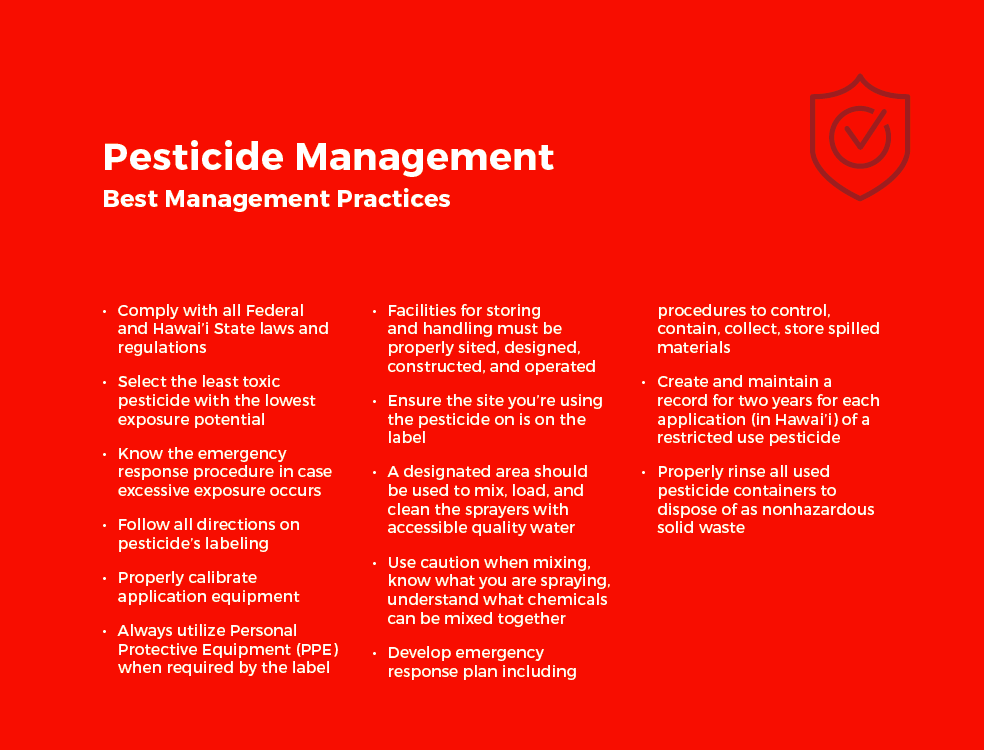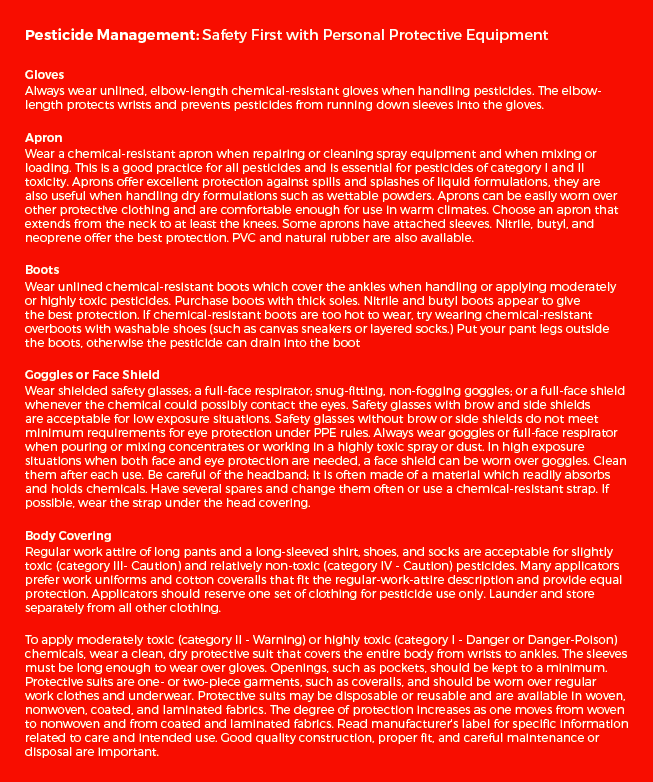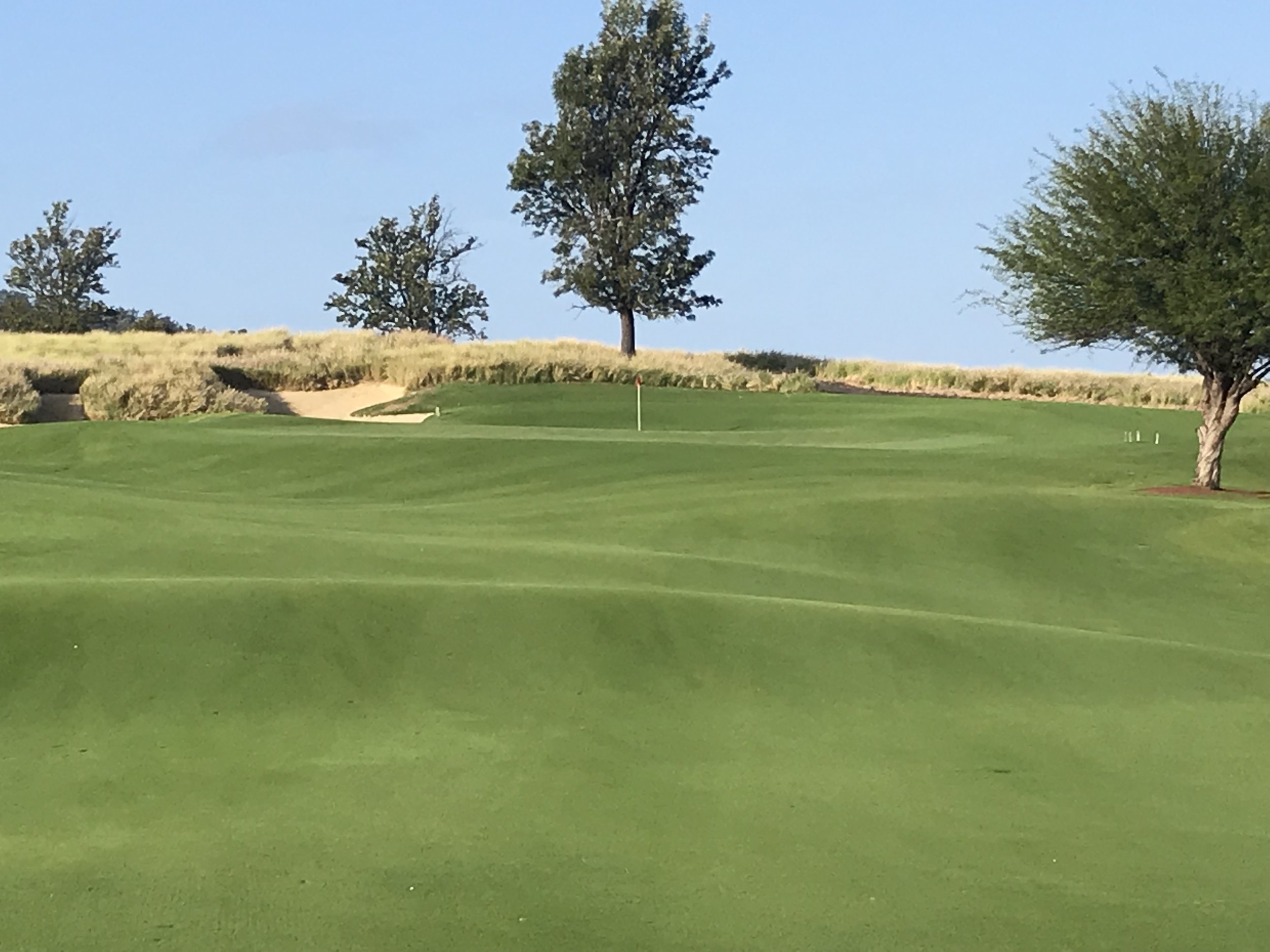10 - Pesticide Management

Pesticide use should be part of an overall pest management strategy that includes biological controls, cultural methods, pest monitoring, and other applicable practices, referred altogether as IPM.
When a pesticide application is deemed necessary, its selection should be based on effectiveness, toxicity to non-target species, cost, site characteristics, and its solubility and persistence in the environment. Pesticides contain active ingredients (the component that targets the pest) and inert ingredients such as solvents, surfactants, and carriers. Both active and inert ingredients may be controlled or regulated by federal, state, and local laws because of environmental and health concerns.
APPLICATION
Responsibilities of Owners, Users, or Handlers
Upon taking possession of a pesticide, the owner, user, or handler takes on two basic responsibilities. One responsibility is to comply with the Hawaiʻi Pesticides Law and the pesticide rules set by the HDOA. The second responsibility is to follow directions on the pesticide’s labeling.
Sprayer Calibration
Properly calibrated application equipment is paramount to mitigating environmental and human health concerns. Personally ensure your spray technician is experienced, licensed, and properly trained. Minimize off-target movement by using properly configured application equipment. It’s good practice to calibrate all application equipment at the beginning of each season (at a minimum) or after equipment modifications. Equipment should be checked daily when in use. Calibration of walk-behind applicators should be conducted for each person making the application to take into consideration their walking speed, etc. Always use recommended spray volumes for the targeted pest to maximize efficacy.
Common turf application equipment found in Hawai’i includes low pressure boom sprayers, backpack or hand can, hand gun, and spreaders.
Restricted Use Pesticides
A RUP is a pesticide that requires regulatory controls in addition to rules for controlling misuse of pesticides. The additional controls ensure only people with special knowledge, skills, equipment, and supplies are allowed to buy, use, or supervise use of RUPs. Pesticide regulators set up a system for controlling pesticide distributors who want to distribute RUPs and pesticide users who want to buy, use, or supervise the use of RUPs. Without this additional system of controls, pesticide regulators would not allow distribution or use of such pesticides. Reference for additional information, licensing, registration, and certification:
https://hdoa.Hawai’i.gov/pi/pest/
Personal Protective Equipment (PPE) & Human Health Risk
Pesticides belong to numerous chemical classes that vary greatly in toxicity. The human health risk associated with pesticide use is related to pesticide toxicity and level of exposure. The risk of a highly toxic pesticide may be very low if the exposure is sufficiently small. Employees will need to wash clothes that may have pesticide residues on them; washing requires the use of hot water with clothes that are suspected to have pesticide residues. Run another empty load once the clothes are washed.
PPE is used for protection against chemicals contacting the person loading, mixing, and spraying the chemical. It is important to read the label thoroughly and use the minimum required PPE listed on the label, users may always choose to use more PPE than required on the label.
ENVIRONMENTAL FATE & TRANSPORT
Storage and handling of pesticides in their concentrated form poses the highest potential risk to ground or surface waters. It is essential that facilities for storing and handling these products be properly sited, designed, constructed, and operated.
Careful thought should be put into selecting pesticides that have a low runoff and leaching potential. Before applying a pesticide, evaluate the impact of site-specific characteristics (e.g., proximity to surface water, water table, and well-heads; soil type; prevailing wind, etc.) and pesticide-specific characteristics (i.e., half-lives and partition coefficients). Always consider selecting pesticides with reduced impact on pollinators and when applied according to the label, have no known effect on endangered species on the property.
Pesticide Transportation, Storage, and Handling
Environmental characteristics of a pesticide can be determined by the environmental hazards statement found on pesticide product labels. The environmental hazards statement (referred to as “Environmental Hazards” on the label and found under the general heading “Precautionary Statements”) provides precautionary language advising the user of potential hazards to the environment from use of the product. The environmental hazards generally fall into three categories: (1) general environmental hazards, (2) non-target toxicity, and (3) endangered species protection.
Store, mix, and load pesticides away from sites that directly link to surface water or groundwater. Locate pesticide storage facilities from other types of structures to allow fire department access. Pesticides should be stored in a lockable concrete or metal building. Storage facility floors should be impervious and sealed with a chemical resistant paint. The floors should have a continuous sill to retain spilled materials and no drains, although a sump may be included, sloped ramps should be provided at the entrance to allow the use of wheeled handcarts for moving material in and out of the storage area safely.
Shelving should be made of sturdy plastic or reinforced metal (metal shelving should be kept painted to avoid corrosion). Wood shelving should never be used, because it may absorb spilled pesticides. Do not store pesticides near burning materials or hot work (welding, grinding), or in shop areas. Automatic exhaust fans and an emergency wash area should be provided. Explosion-proof lighting may be required. Light and fan switches should be located outside the building, so that both can be turned on before staff enter the building and turned off after they leave the building. Avoid temperature extremes inside the pesticide storage facility.
PPE should be easily accessible and stored immediately outside the pesticide storage area. Do not transport pesticides in the passenger section of a vehicle and never leave pesticides unattended during transport. Place a spill containment kit in the storage area, in the mix/load area, and on the spray rig.
Mixing
Use caution when mixing concentrated chemical and handling around the mix load area and wear the correct PPE. Mixing is an important part of proper spraying application. It is important to know what you are spraying and what chemicals can be mixed together. If you are uncertain, a jar test should be done to make sure the chemicals are compatible. A jar test is a simple method of using small samples of the mixture and mixing in a small jar. This will allow you to observe the reaction and make sure a complete mixture can be achieved. Some chemicals when mixed together could form a thick solution making it hard to spray and clean the tank. The specific mixing and sequence of mixing instructions on the label should be followed. No chemicals should be mixed without proper supervision. Management should always be involved in the selection and initial stages of mixing to avoid accidents. The most common accidents occur by staff misunderstanding the rates, distractions, and mixing of the wrong materials. Practice WALES mixing; Wettable powder/flowables, agitate, liquid flowables, emulsifiable concentrates, surfactants last.
It is generally common to fill the tank half full of water and pour in the chemicals while the pump is running. Continue to fill the tank with water until reaching the desired amount needed to make the application.
Mix and Wash Station
A designated area with accessible quality water should be used to mix, load, and clean sprayers. Locate it closer to the chemical storage building to reduce chance of spills from transport. Mix load pads have become an important part of the maintenance facility to keep ground water safe from spills.
Mix load areas can be made of materials such as concrete, durable synthetics, or aluminum. Many companies offer off the truck containment for mix load pads and can be set up easily. The pad should be large enough to contain any spilled solution. Part of the area should contain a sump or pump to remove spills from the containment. Ideally, cover the pad to keep rain water from accumulating in the holding bay.
PPE such as eye wash stations, wash shower, and other safety equipment should be stored close to the mix pad area and available if needed. Rinse used containers during the mixing and loading process and add rinsate water to the finished spray mix.
Pesticide Container Disposal
Rinse empty pesticide containers immediately in order to remove the most residue. Rinsate must be used for the pesticides intended use or managed as hazardous waste. Rinse emptied pesticide containers by either triple rinsing or pressure rinsing. Empty pesticide containers are classified as hazardous wastes if not properly rinsed, and as a result would be subject to regulations governing hazardous waste. Federal law (FIFRA) requires pesticide applicators to rinse all empty pesticide containers before taking other container disposal steps. Under the federal Resource Conservation and Recovery Act, or RCRA, a pesticide container is not empty until it has been properly rinsed. The improper disposal of a hazardous waste can result in fines and/or criminal penalties. Pesticide containers that have been properly rinsed can be handled and disposed of as nonhazardous solid waste.
Puncture or crush empty and rinsed pesticide containers and dispose of according to the label. It is against the law to use empty pesticide containers for another function. Empty containers must be rendered unusable and discarded.
EMERGENCY PREPAREDNESS & SPILL RESPONSE
Accidents happen. Advance preparation on what to do when an accident occurs is essential to mitigate human health effects and environmental impact. Any material that collects on the pad must be applied as a pesticide according to the label or disposed of as a (potentially hazardous) waste according to state laws and regulations. Clean up spills immediately.
Develop a golf course facility emergency response plan which includes procedures to control, contain, collect, and store spilled materials. Prominently post “Important Telephone Numbers” including CHEMTREC, for emergency information on hazards or actions to take in the event of a spill. Ensure an adequately sized spill containment kit is readily available. Designate a spokesperson who will speak on behalf of the facility should an emergency occur and it’s good practice to host a tour for local emergency response teams (for example, fire fighters, etc.) to show them the facilities and discuss the emergency response plan.
PESTICIDE RECORD KEEPING
This is a guide to the State of Hawai’i Department of Agriculture’s rules for making and keeping records of applications of RUPs in Hawai’i. The rules specify: Two kinds of restricted use pesticides are sold in Hawai’i. Federal restricted use pesticides have labels that bear a restricted use pesticide statement in a box near the top of the label’s front panel. (See example below.) State restricted use pesticides do not have such labels, but dealers who stock these pesticides can identify them.
Typical box on front panel of a label of a federal restricted use pesticide.
Names of restricted use pesticide products may be found online through the Hawai’i Department of Agriculture: http://hdoa.Hawai’i.gov/pi/pest/.
Hawai’i-certified applicators are responsible for creating and keeping a record for each application (in Hawai’i) of a RUP they have purchased or otherwise acquired. Always review required information to record, per Hawai’i regulation, and maintain records for two years at the principal place of business. Use records to monitor pest control efforts and plan future management decisions, use electronic or hard-copy forms and software tools to properly track pesticide inventory and use, develop and implement a pesticide drift management plan, and keep a backup set of records in a safe, separate storage area.
HAWAI’I STATE REGULATIONS FOR PESTICIDE USE
The State of Hawai’i (Department of Agriculture, Department of Health, Department of Transportation, etc.) has regulations covering practically anyone who manufactures, formulates, markets, and uses pesticides. Act 45, passed by the 2018 Hawai’i legislature, requires all Certified Applicators of Restricted Use Pesticides (RUP) to submit a report to the HDOA of the RUP applied by Jan 30 of each year. Records that are required to be reported to HDOA include: Name/entity, applicator number, reporting year, permit number (if applicable), product name, EPA registration number, active ingredient(s) and percent, total used, area treated, date applied, and tax map key.
Act 45 also requires that all uses of chlorpyrifos and products which contain chlorpyrifos require a permit issued by the Hawai’i Department of Agriculture Pesticides Branch. All uses and sale of chlorpyrifos in Hawai’i will be banned and permitting of its use will cease as of 2023. Any chlorpyrifos permits that extend past December 31, 2022 will be terminated as of January 1, 2023. Reference additional information and access to the P-45 Registration Form at:
http://hdoa.Hawai’i.gov/pi/main/act45/
http://hdoa.Hawai’i.gov/pi/main/p-45-instructions/
http://hdoa.Hawai’i.gov/pi/pest/pesticides-rules-and-laws/
Reference IPM section for additional information.












